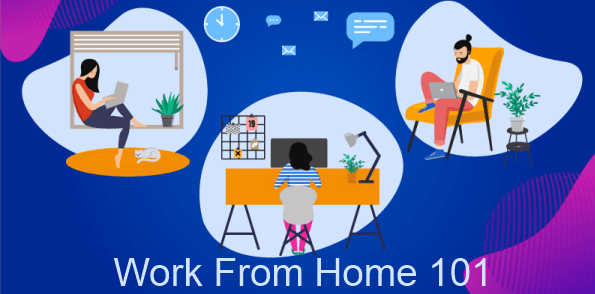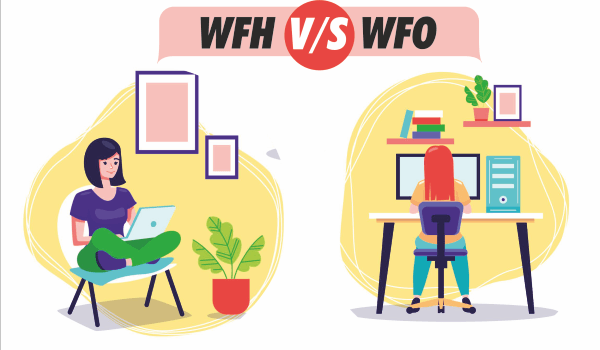What is the full form of WFHWFH: Work from HomeWFH stands for work from home. A work arrangement in which employees do not commute to a central location of employment, such as an office building, warehouse, or retail store, is known as remote work. It is also known as work from home (WFH), work from any place, telework, remote job, mobile work, and distance work. 
In the past, artisans practised crafts like woodwork, ceramics, whole-grain meals, and smithing from their homes and did business from there itself. Factory construction resulted from the Industrial Revolution, which created centralized workplaces. HistoryIn early 1970's, a technology was created that used telephone lines as a network bridge to connect remote offices to downtown mainframes via dumb terminals. Jack Nilles first used the terms "telecommuting" and "telework" in 1973. As an experiment, five IBM workers were allowed to work from home in 1979, and the project included 2,000 participants by 1983. By the beginning of the 1980s, home employees and branch offices may use terminal emulators and personal computers to connect to the organization's mainframes. 
The adage "work is love" was adopted as it was said, "something you do, not something you travel. This adage has been rephrased as "Work is what we do, not where we are". In the Information Age, numerous enterprises began operating in the homes of business owners with limited funding. The acceptance of remote work has been steadily increasing since the 1980s. For instance, from 2003 to 2006, 4 million more individuals began working from home, and, in 1983, academicians also started experimenting with web conferencing. Technology such as collective software, virtual personal webs, meeting calling, videotelephony, internet access, cloud computing, voice over I.P. (VoIP), mobile telecommunications technology such as a Wi-Fi-enabled laptop or tablet computer, smartphones, and other devices made it easier for people to work remotely in the 1990s and 2000s. Individually executive agency in the United States was mandated by the Telework Enhancement Act of 2010 to create policies that allowed remote work to the most significant capacity, provided that worker execution was not affected. Millions of people started working remotely for the preferably period during the COVID-19 pandemic, and many students shifted to distance learning. StatisticsAccording to the European Investment Bank Climate Survey, 36% of respondents agreed that favouring remote work will help combat climate change. In September 2021, a Gallup survey found that 45 percent of full-time U.S. employees worked from home, with 25 percent doing so constantly and 20 percent doing so occasionally. 
In the European Union, 12.3 percent of workers aged 15 to 64, including 13.2 percent of women and 11.5 percent of men, typically worked from home in 2020. By nation, Finland (25.1%), Luxembourg (23.1%), Ireland (21.5%), Austria (18.1%), and the Netherlands (17.8%) had the highest percentage of workers who worked from home. In comparison, Bulgaria (1.2%), Romania (2.5%), Croatia (3.1%), Hungary (3.6%), and Latvia had the lowest rate (4.5 percent). In the U.S., 91 percent of those who presently perform from residence stated they would want to do so in the future. Fifty-four percent of employees in Gallup's September 2021 study said they thought remote work would not change the company culture, while 12 percent thought it would improve and 33 percent thought it would worsen. The United States Office of Personnel Management reports that agencies saved more than $180 million in fiscal 2020 due to agencies allowing 50% of all U.S. federal employees to work remotely. BenefitsAlthough this is the topic of lawsuits, some employee expenses, such as office expenses, can be transferred to a remote employee. Remote workers spend less on transportation, dining out, and apparel. Additionally, working remotely lowers travel expenses, increases productivity by reducing commute times, and decreases time spent in traffic jams. 
Numerous studies have demonstrated the impact of job factors on employee attitudes and behaviour. Job SatisfactionJob features and job satisfaction have a moderately substantial correlation. The characteristic job theory states that if a job has all five of the following characteristics-skill variety, task identity, task significance, autonomy, and feedback-an employee will be more internally motivated to work, satisfied with the opportunities for personal growth, generally satisfied with their job, perform better on the job, and experience less absenteeism and turnover. 
A change in skill variety, job identity, or task relevance has less of an impact on work behaviours and attitudes than changes in autonomy and feedback, both of which are impacted by remote work status. The association between liberation and job happiness is the strongest of the five task qualities, with greater independence resulting in higher job satisfaction. Because their professions allow for flexibility and freedom, remote workers might feel more content. We discovered that remote workers were more satisfied than office-based workers. According to research, independence decreased work-family tensions, enhancing distant workers' satisfaction. Employee engagement grew as the amount of time spent working remotely increased, according to autonomy. When a job offers freedom, independence, and scheduling flexibility, the employee should feel accountable for the results of their work since autonomy influences experienced responsibility. Because there are more options available to a worker while they are not in the office, remote employment offers independence and scheduling flexibility. Remote workers can schedule their work at different times of the day and are not bound by office schedules. Employees who work remotely have the freedom to choose their workspace, schedule, and even attire, enabling them to produce their best work. If remote workers feel in charge of and responsible for their work, they may feel more accountable. Remote work's autonomy makes work-family conflicts less likely. Working from home allows you to schedule your time around your family. One of its key draws is having more control over daily obligations. The degree of autonomy that a remote worker experiences varies on several variables, such as scheduling flexibility and family size. Problems with hobbies are decreased in addition to conflicts with the workplace and family. Workers can engage in more social and physical recreation due to more freedom and reduced time constraints. Studies also suggest that to maintain a healthy work/life balance, autonomy must be tempered with a high level of discipline. Environmental AdvantagesSome businesses encourage remote work to lessen air pollution and traffic congestion. After all, fewer vehicles are on the roads. Most research concludes that remote work generally results in lower energy use because less time is spent using energy-intensive personal transportation. Cleaner air is also a result of remote work. Since businesses no longer need amenities like air conditioning, WiFi, canteens, etc., remote work has also decreased the amount of electricity used. 
The rise in remote work during the COVID-19 lockdowns resulted in a decline in worldwide CO2 emissions. Carbon emissions decreased by 5.4 percent, partly because fewer people commuted by automobile, but they rose to the same level the following year. However, as remote work has become more prevalent, many have left cities favouring more prominent residences with home offices. Productivity and Advantages for EmployeesEmployee productivity has long been cited as a significant benefit of remote work. According to a review of data until March 2021, over six out of ten employees indicated they were more productive working from home than anticipated, compared to 14 percent who said they got less done. Employee effort and dedication are far more likely to be evaluated based on production or results in remote employment because working hours are less restricted. Employers can see the results of non-productive job activities (research, self-training, resolving technical issues or equipment breakdowns) and time spent on failed attempts (early draughts, pointless initiatives, failing discoveries). Increased Flexibility and Accountability For EmployeesThe sociotechnical systems (STS) hypothesis explains social and technology interactions. To create work that improves worker satisfaction and boosts productivity, STS analyses the connections between people, technology, and the workplace. The theory can be used to develop remote work, initially designed to explain the contradiction of more superior technology but decreasing productivity. The minimal critical specification is one of the STS tenets. According to this approach, objectives and task details should only be minimally specified unless necessary to avoid limiting possibilities or impeding productive work. Workers who operate remotely can choose how and when to do their tasks. Similarly, remote employees are accountable for using their tools and resources to fulfil their duties. This rise in power and responsibility for their work supports the impression that working remotely is a privilege and, in specific organizations, even a promotion. Lower Intention to Leave and More LoyaltyRemote workers generally have reduced turnover intentions or the willingness to leave the company. More splendid professional isolation among remote workers was associated with a reduced intention to leave. A 2001 study indicated that the quality of job output increased, and we reduced turnover intentions among remote workers by boosting feedback and task identification through clear communication of goals, objectives, and expectations. According to surveys conducted by FlexJobs, 81% of participants indicated having flexible work options would make them more loyal to their employers. More than half of the workers surveyed in a 2021 study by McKinsey & Company said they favoured businesses using a hybrid work model. Whereas more than a quarter said they would consider changing professions if their present employer discontinued remote work possibilities. Benefits and Drawbacks Of Meta-AnalysisAccording to a 2007 meta-analysis of 46 research on remote work involving 12,833 individuals published in the Journal of Applied Psychology by the American Psychological Association (APA) by Ravi Gajendran and David A. Harrison, remote employment generally benefits both employees and companies. Gajendran and Harrison discovered in their meta-analytic study that employees' job satisfaction, perceived autonomy, stress levels, manager-rated job performance, and (reduced) work-family conflict were all somewhat but favourably impacted by remote work. Working remotely decreases the intention to quit one's employment or turnover intent. Due partly to less work-family conflict, remote work has increased job satisfaction, reduced role stress, and decreased turnover intention. Additionally, the rise in autonomy brought on by remote work raises satisfaction at work. 
The meta-analysis discovered that there are no consistently adverse effects on workplace relationships and career outcomes, despite previous concerns from several scholars and managers that employee careers might suffer and workplace relationships might be harmed due to remote work. We found the quality of the supervisor-employee connection partially responsible for the association between job satisfaction and desire to leave. In contrast, we found remote work to improve employee-supervisor relations. Only intense remote work, in which workers are at home for more than 2.5 days a week, harms employee relationships with coworkers, even though it lessens work-family conflict. During the early weeks of the epidemic, a factor analysis revealed the general distribution of people's experiences and the benefits and drawbacks of WFH. The findings showed that most people experienced WFH during the lockdown more favourably than unfavourably. Three elements represent the primary benefits of WFH are a better work-life balance, more productivity, more control over one's work. The most significant drawbacks were constraints related to working from home, work uncertainty, and insufficient tools. Potential Issues and DownsidesLack of face-to-face encounters. We cannot replicate in-person office interactions with current communication technology, and the potential for errors and misunderstandings might grow. According to the media richness theory, face-to-face contact allows for the processing of rich information. We can explain confusing topics, give immediate feedback, and communicate individually (e.g. body language, tone of voice). Communication during remote work must occur via various channels, including the phone and email. Telephone discussions make it more challenging to understand the feelings of the person or team on the other end of the line, emails have a time gap that prevents fast feedback, and neither of these kinds of communication allows one to see the other. Thus, in foreign labour, typical organizational communication patterns are changed. Compared to face-to-face groups, teams employing computer-mediated communication and computer conferencing take longer to reach conclusions. Employees typically find face-to-face contacts, phone calls, and in-person departmental meetings satisfactory ways to receive messages. Still, email and the Internet do not improve this level of satisfaction. Although one study indicated that virtual workers in a team were more satisfied with their technology-mediated communication than their in-person office contact, it shows that remote work may not have the components for "rich communication" compared to face-to-face encounters. Face-to-face contacts foster closer relationships, a sense of belonging, and trust. Consequently, 54% of distant employees believed they missed social engagement, and 52.5% thought they missed out on professional interaction. Relationships between remote employees and their co-workers can suffer, especially if those co-workers do not work remotely. Co-workers who aren't allowed to work remotely may feel bitter and envious since they may think it's unfair that they can't do the same. However, despite fewer interpersonal interactions and more professional isolation, a meta-analysis of remote work did not uncover evidence of unfavourable relationships between remote employees and their co-workers or supervisors. The adaptive structuration theory examines changes in organizations as new technologies are adopted. According to adaptive structural theory, structures (generic guidelines and tools provided by technology) might be distinct from structuration (how people use these rules and resources), the intended application of technology and how individuals utilize it interact.
Next TopicFull Form
|
 For Videos Join Our Youtube Channel: Join Now
For Videos Join Our Youtube Channel: Join Now
Feedback
- Send your Feedback to [email protected]
Help Others, Please Share










